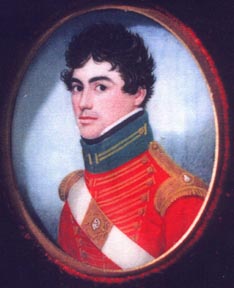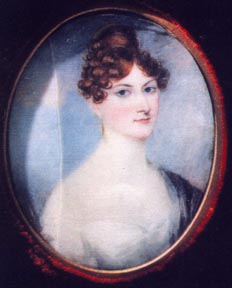Background
Military Record
Battle of Crysler’s Farm
Family
Bibliography
Links

This page was set up by Robert Sewell in September 2013.
Contents
Background |  |
It has been proven conclusively by DNA analysis that John St. Alban Sewell was a son of Chief Justice Jonathan Sewell. For details, see Eben W. Graves, "Sewall Family DNA: A Project Status Report", American Ancestors, Summer 2010, page 45. This is a publication of the New England Historic Genealogical Society.
John St. Alban Sewell was baptised in September of 1793 as the natural child (i.e., born without the parents having undertaken the formality of a church marriage) of Chief Justice Jonathan Sewell and Elizabeth Cornfield. For years, the family story was that Elizabeth Cornfield didn’t exist and John St. Alban was the son of Edward Augustus Hanover, Duke of Kent and his much loved and devoted common law wife of over twenty years, Mdm. Julie St. Laurent.
However, in March 2000, the diligent research of Ms. Deborah Carroll revealed that Elizabeth Cornfield not only existed, but that she was present, along with Jonathan Sewell, at the baptism of John St. Alban on September 22, 1793. In 2010, DNA research by Eben W. Graves proved conclusively that John St. Alban Sewell was a son of Chief Justice Jonathan Sewell.
As for Elizabeth Cornfield, she married Sergeant John Finch, a musician of the Royal Fusiliers, on November 19, 1793. No other records have been found, and it is to be hoped that they "lived happily ever after".
The following notes are quoted from
W. Darcy McKeough, The Sewell Family Record (unpublished) and were provided
by John St. Alban Sewell’s great-great grandson, Stephen Walker Sewell,
2071 Rte. 329, St. Agathe Nord, Quebec, PQ, J8C 2Z8.
John St. Alban Sewell was barely twenty years of age and already a lieutenant at the Battle of Crysler’s Farm on November 11, 1813. The following excerpt from Pierre Berton, Flames Across the Border 1813-1814, Toronto, McClelland and Stewart, 1981
"JOHN CRYSLER’S FARM, St. Lawrence River, Upper Canada, November 11, 1813
"As the three dragoons dash through the ranks of the 49th Regiment, Lieutenant John Sewell is in the act of toasting a piece of breakfast pork on the point of his sword. He needs hot nourishment, for he has slept on the cold ground all night, his firelock between his legs to protect it from the icy rain, laced with sleet. Now it seems, there will be no time for breakfast, as his company commander shouts to him: "Jack, drop cooking, the enemy is advancing." The British troops are scrambling into position behind a stout rail fence, but the warning is several hours premature.
"At his headquarters in the Crysler farmhouse, hard by the King’s Highway that runs along the riverbank, Colonel Morrison assesses his position. He has been chasing (the American General) Wilkinson in Mulcaster’s gunboats for five days, ever since word reached Kingston that the main American attack would be on Montreal. Now he has caught up with him. Will the Americans stand and fight or will the chase continue? With a force of only eight hundred men to challenge Wilkinson’s seven thousand, Morrison is not eager for a pitched battle. But if he must have one, it will be on ground of his choosing — a European-style battle here on an open plain where his regulars can manoeuvre, as on a parade ground, standing shoulder to shoulder in two parallel lines, each man occupying twenty-two inches of space, advancing with the bayonet, wheeling effortlessly when ordered, or moving into echelon — a staggered series of platoons, each supporting its neighbour."
* * * *
John Sewell, the British lieutenant whose breakfast was so rudely interrupted, is standing with his fellow Green Tigers in the thin line formed by the two British regiments when he sees the grey-clad Voltigeurs burst from the woods on his left, pursued by the Americans. The situation is critical. If Ripley’s men can get around the 89th, which holds the left flank, and attack the British from the rear, the battle is as good as lost."
* * * *
"John Sewell, advancing with his company into the hail of grape, sees his captain killed, takes over, and suddenly spies a squadron of American dragoons galloping down the King’s road on his right. He realizes the danger: if the horsemen get around the flank, they can wheel about and charge the British from the rear. Fortunately, another drill book manoeuvre exists to meet this threat. Captain Ellis on the right wing executes it under Plenderleath's command, wheeling his men backward to the left to face the line of cavalry. Sewell notes that the entire movement, which the Americans believe to be a retreat, is carried out with all the coolness of a review as the commands ring out over the crash of grape and canister: Halt. . . Front. . .Pivot. . . Cover. . .Left wheel into line. . .Fire by platoons from the centre to the flank. The effect is shattering as the wounded American horses, snorting and neighing, flounder about, their saddles empty."
 |
 |
|
d. 1849 |
1793 - 1875 |
John St. Alban Sewell married Margaret Hobbs, daughter of Attorney William Hobbs of Cork, on October 20, 1821. They had the following children, three of whom (Edmund, Robert and Henrietta) he named the same or nearly the same as his siblings:
|
|
Please visit Deborah Carroll's page about The Paternity of John St. Alban Sewell.
Please visit the Sewell Genealogy Site Map for more pages in this series.
Use your browser’s Back Button or click a link to return to:
Return to the top of this page